Nursing Professionalism and Code of Conduct: A Comprehensive Report
VerifiedAdded on 2021/05/31
|8
|2104
|65
Report
AI Summary
This report delves into the critical aspects of nursing professionalism and code of conduct, emphasizing the importance of ethical guidelines and patient confidentiality within the Australian healthcare system. It explores the definition of professionalism, the roles of regulatory bodies, and the implications of social media use by healthcare professionals, using a case study involving a nursing student who shared a patient's photo on social media. The report examines the ethical and legal issues arising from such actions, including violations of patient privacy and confidentiality, and the importance of adhering to the Nursing and Midwifery Board of Australia's guidelines. It also discusses the potential positive and negative impacts of social media in healthcare, the significance of maintaining professional boundaries, and the need for nurses to act with compassion, competence, and a strong sense of ethical responsibility. The report concludes by highlighting the need for healthcare professionals to be aware of the implications of social media use on professionalism, ethics, and patient relationships.
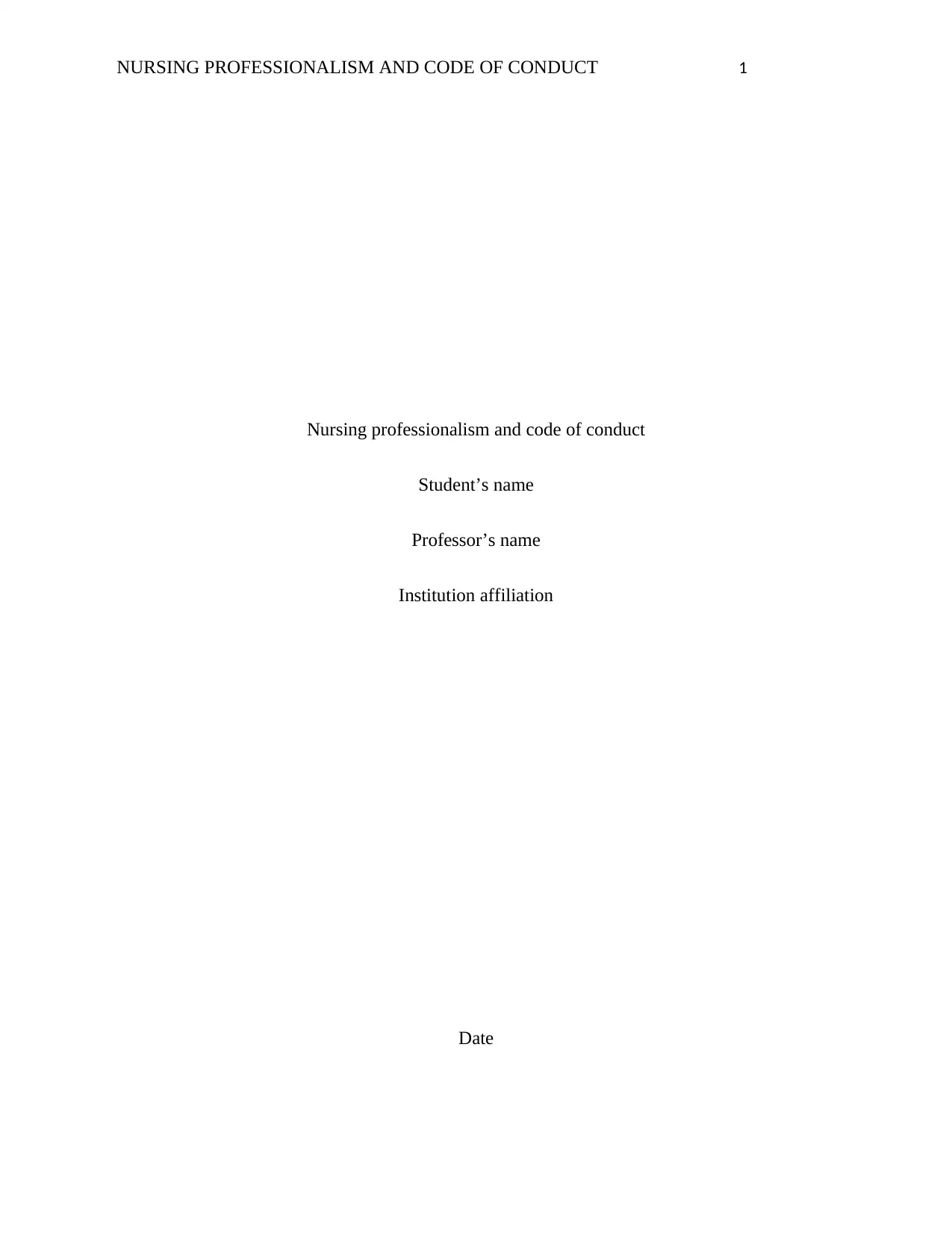
NURSING PROFESSIONALISM AND CODE OF CONDUCT 1
Nursing professionalism and code of conduct
Student’s name
Professor’s name
Institution affiliation
Date
Nursing professionalism and code of conduct
Student’s name
Professor’s name
Institution affiliation
Date
Paraphrase This Document
Need a fresh take? Get an instant paraphrase of this document with our AI Paraphraser
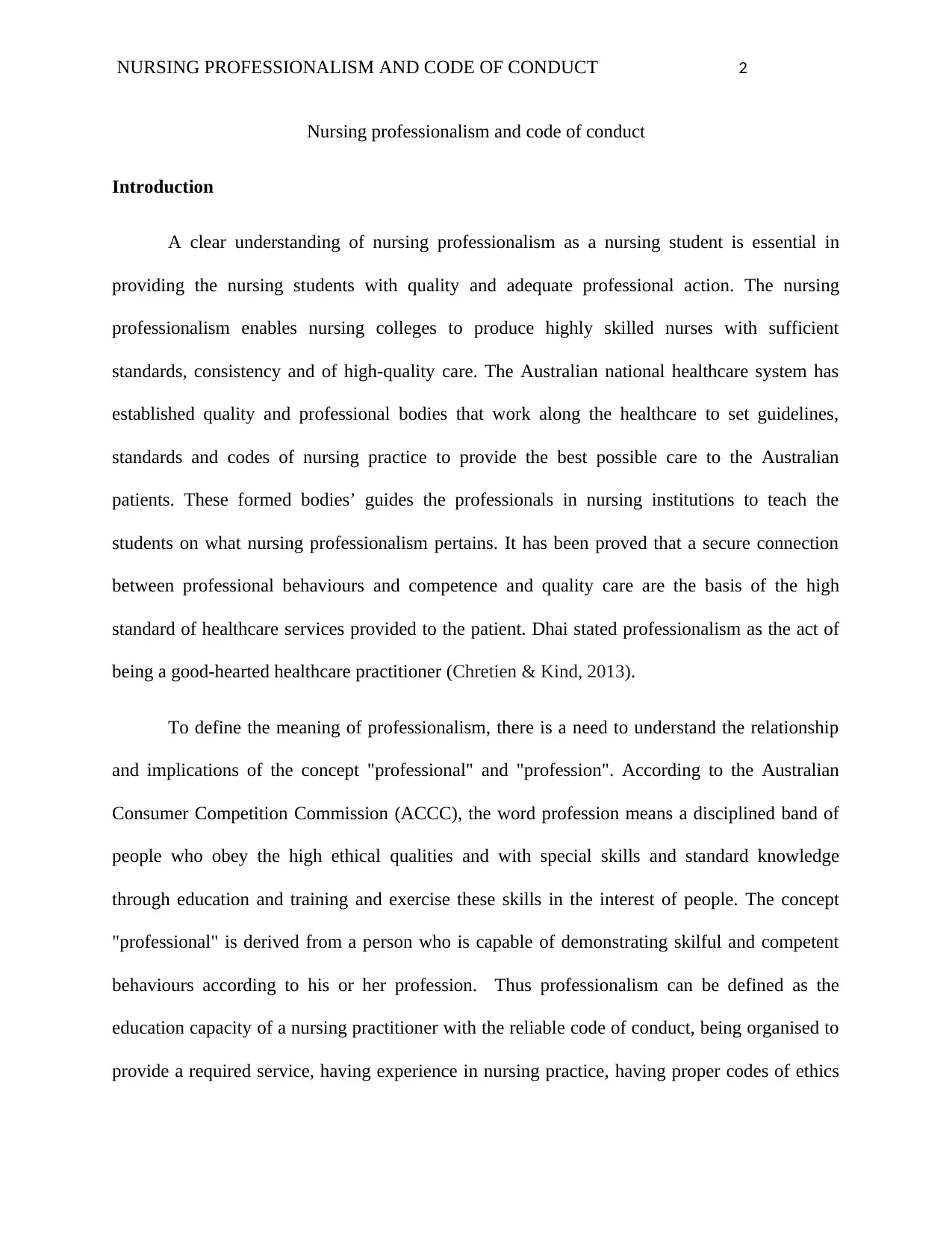
NURSING PROFESSIONALISM AND CODE OF CONDUCT 2
Nursing professionalism and code of conduct
Introduction
A clear understanding of nursing professionalism as a nursing student is essential in
providing the nursing students with quality and adequate professional action. The nursing
professionalism enables nursing colleges to produce highly skilled nurses with sufficient
standards, consistency and of high-quality care. The Australian national healthcare system has
established quality and professional bodies that work along the healthcare to set guidelines,
standards and codes of nursing practice to provide the best possible care to the Australian
patients. These formed bodies’ guides the professionals in nursing institutions to teach the
students on what nursing professionalism pertains. It has been proved that a secure connection
between professional behaviours and competence and quality care are the basis of the high
standard of healthcare services provided to the patient. Dhai stated professionalism as the act of
being a good-hearted healthcare practitioner (Chretien & Kind, 2013).
To define the meaning of professionalism, there is a need to understand the relationship
and implications of the concept "professional" and "profession". According to the Australian
Consumer Competition Commission (ACCC), the word profession means a disciplined band of
people who obey the high ethical qualities and with special skills and standard knowledge
through education and training and exercise these skills in the interest of people. The concept
"professional" is derived from a person who is capable of demonstrating skilful and competent
behaviours according to his or her profession. Thus professionalism can be defined as the
education capacity of a nursing practitioner with the reliable code of conduct, being organised to
provide a required service, having experience in nursing practice, having proper codes of ethics
Nursing professionalism and code of conduct
Introduction
A clear understanding of nursing professionalism as a nursing student is essential in
providing the nursing students with quality and adequate professional action. The nursing
professionalism enables nursing colleges to produce highly skilled nurses with sufficient
standards, consistency and of high-quality care. The Australian national healthcare system has
established quality and professional bodies that work along the healthcare to set guidelines,
standards and codes of nursing practice to provide the best possible care to the Australian
patients. These formed bodies’ guides the professionals in nursing institutions to teach the
students on what nursing professionalism pertains. It has been proved that a secure connection
between professional behaviours and competence and quality care are the basis of the high
standard of healthcare services provided to the patient. Dhai stated professionalism as the act of
being a good-hearted healthcare practitioner (Chretien & Kind, 2013).
To define the meaning of professionalism, there is a need to understand the relationship
and implications of the concept "professional" and "profession". According to the Australian
Consumer Competition Commission (ACCC), the word profession means a disciplined band of
people who obey the high ethical qualities and with special skills and standard knowledge
through education and training and exercise these skills in the interest of people. The concept
"professional" is derived from a person who is capable of demonstrating skilful and competent
behaviours according to his or her profession. Thus professionalism can be defined as the
education capacity of a nursing practitioner with the reliable code of conduct, being organised to
provide a required service, having experience in nursing practice, having proper codes of ethics
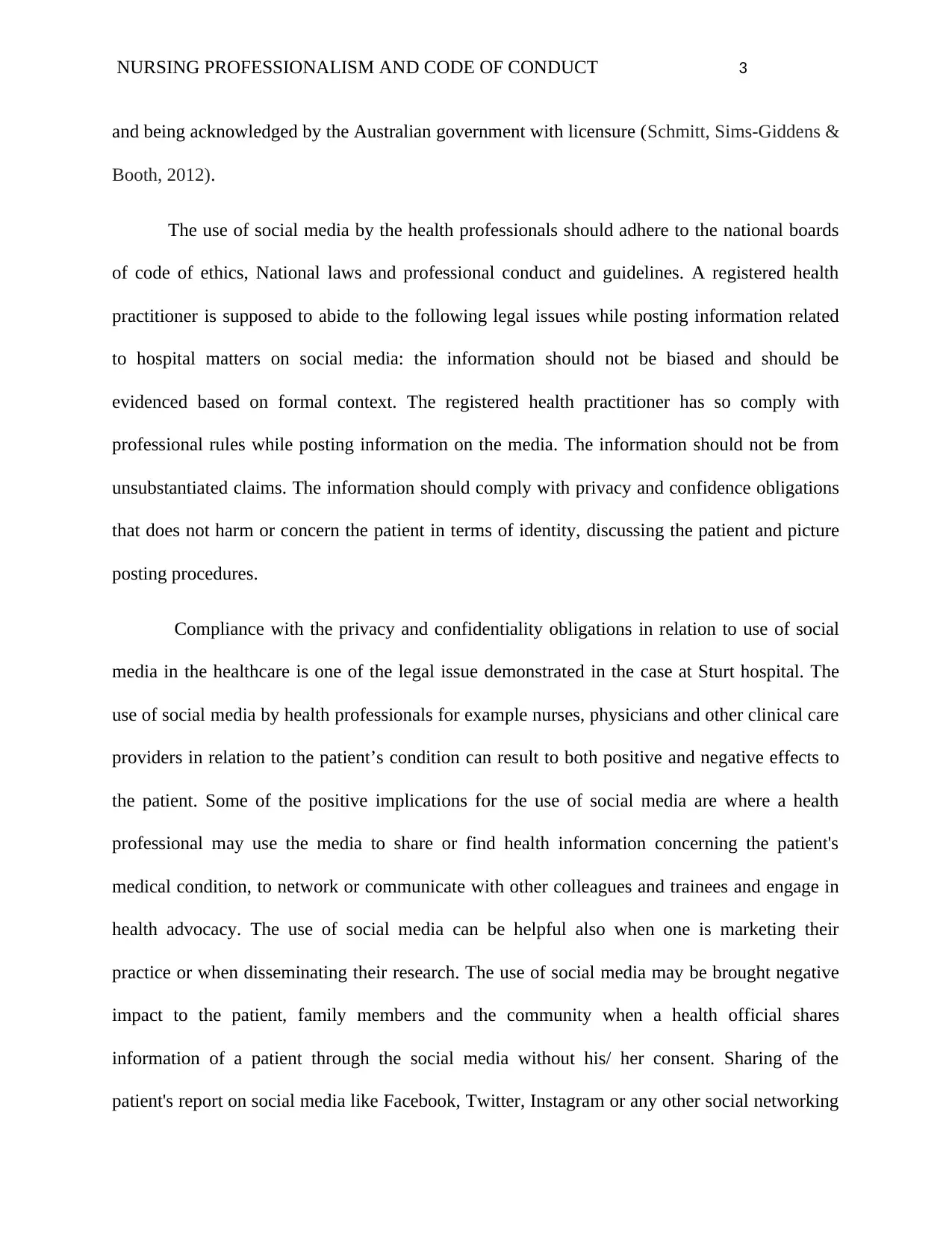
NURSING PROFESSIONALISM AND CODE OF CONDUCT 3
and being acknowledged by the Australian government with licensure (Schmitt, Sims-Giddens &
Booth, 2012).
The use of social media by the health professionals should adhere to the national boards
of code of ethics, National laws and professional conduct and guidelines. A registered health
practitioner is supposed to abide to the following legal issues while posting information related
to hospital matters on social media: the information should not be biased and should be
evidenced based on formal context. The registered health practitioner has so comply with
professional rules while posting information on the media. The information should not be from
unsubstantiated claims. The information should comply with privacy and confidence obligations
that does not harm or concern the patient in terms of identity, discussing the patient and picture
posting procedures.
Compliance with the privacy and confidentiality obligations in relation to use of social
media in the healthcare is one of the legal issue demonstrated in the case at Sturt hospital. The
use of social media by health professionals for example nurses, physicians and other clinical care
providers in relation to the patient’s condition can result to both positive and negative effects to
the patient. Some of the positive implications for the use of social media are where a health
professional may use the media to share or find health information concerning the patient's
medical condition, to network or communicate with other colleagues and trainees and engage in
health advocacy. The use of social media can be helpful also when one is marketing their
practice or when disseminating their research. The use of social media may be brought negative
impact to the patient, family members and the community when a health official shares
information of a patient through the social media without his/ her consent. Sharing of the
patient's report on social media like Facebook, Twitter, Instagram or any other social networking
and being acknowledged by the Australian government with licensure (Schmitt, Sims-Giddens &
Booth, 2012).
The use of social media by the health professionals should adhere to the national boards
of code of ethics, National laws and professional conduct and guidelines. A registered health
practitioner is supposed to abide to the following legal issues while posting information related
to hospital matters on social media: the information should not be biased and should be
evidenced based on formal context. The registered health practitioner has so comply with
professional rules while posting information on the media. The information should not be from
unsubstantiated claims. The information should comply with privacy and confidence obligations
that does not harm or concern the patient in terms of identity, discussing the patient and picture
posting procedures.
Compliance with the privacy and confidentiality obligations in relation to use of social
media in the healthcare is one of the legal issue demonstrated in the case at Sturt hospital. The
use of social media by health professionals for example nurses, physicians and other clinical care
providers in relation to the patient’s condition can result to both positive and negative effects to
the patient. Some of the positive implications for the use of social media are where a health
professional may use the media to share or find health information concerning the patient's
medical condition, to network or communicate with other colleagues and trainees and engage in
health advocacy. The use of social media can be helpful also when one is marketing their
practice or when disseminating their research. The use of social media may be brought negative
impact to the patient, family members and the community when a health official shares
information of a patient through the social media without his/ her consent. Sharing of the
patient's report on social media like Facebook, Twitter, Instagram or any other social networking
⊘ This is a preview!⊘
Do you want full access?
Subscribe today to unlock all pages.

Trusted by 1+ million students worldwide
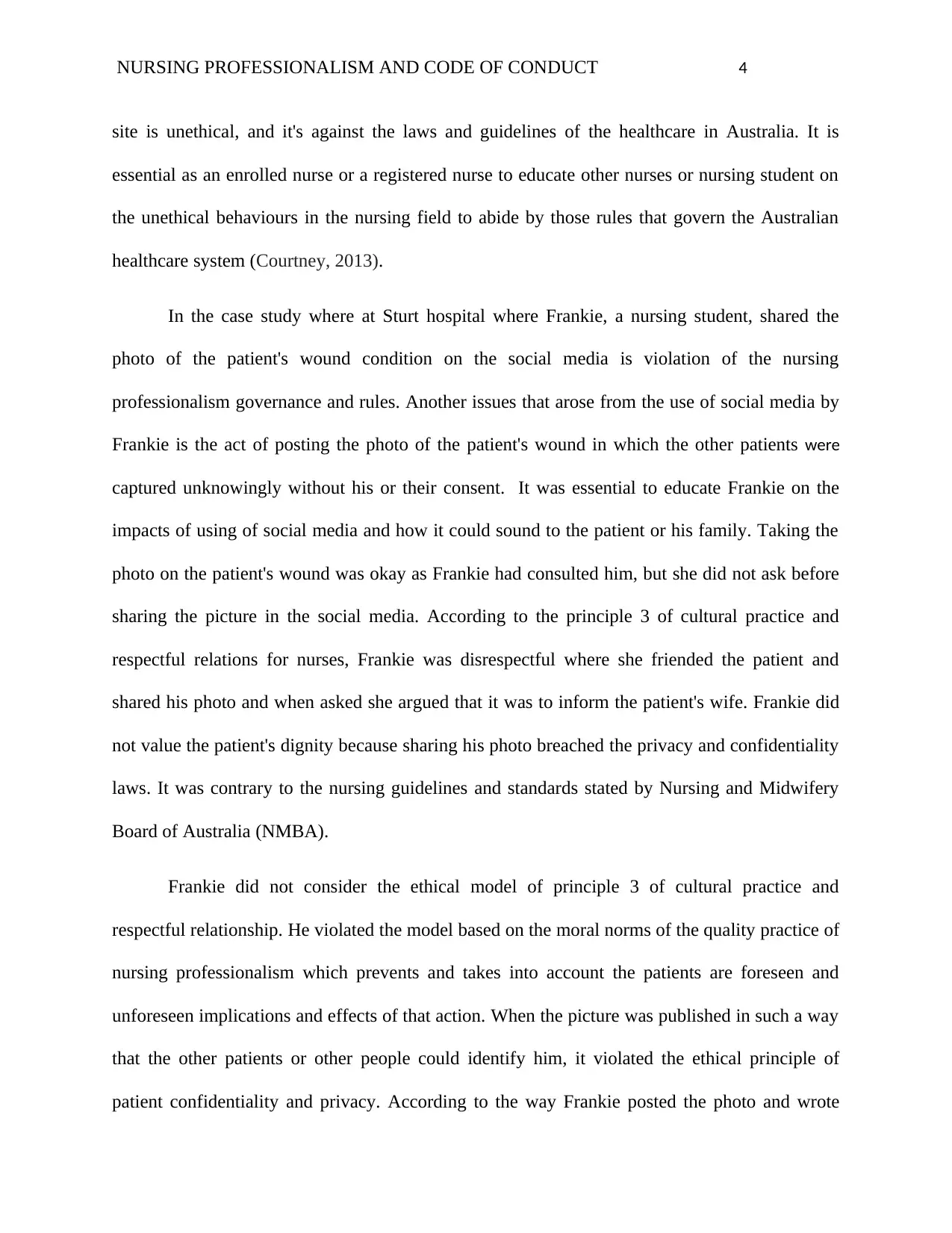
NURSING PROFESSIONALISM AND CODE OF CONDUCT 4
site is unethical, and it's against the laws and guidelines of the healthcare in Australia. It is
essential as an enrolled nurse or a registered nurse to educate other nurses or nursing student on
the unethical behaviours in the nursing field to abide by those rules that govern the Australian
healthcare system (Courtney, 2013).
In the case study where at Sturt hospital where Frankie, a nursing student, shared the
photo of the patient's wound condition on the social media is violation of the nursing
professionalism governance and rules. Another issues that arose from the use of social media by
Frankie is the act of posting the photo of the patient's wound in which the other patients were
captured unknowingly without his or their consent. It was essential to educate Frankie on the
impacts of using of social media and how it could sound to the patient or his family. Taking the
photo on the patient's wound was okay as Frankie had consulted him, but she did not ask before
sharing the picture in the social media. According to the principle 3 of cultural practice and
respectful relations for nurses, Frankie was disrespectful where she friended the patient and
shared his photo and when asked she argued that it was to inform the patient's wife. Frankie did
not value the patient's dignity because sharing his photo breached the privacy and confidentiality
laws. It was contrary to the nursing guidelines and standards stated by Nursing and Midwifery
Board of Australia (NMBA).
Frankie did not consider the ethical model of principle 3 of cultural practice and
respectful relationship. He violated the model based on the moral norms of the quality practice of
nursing professionalism which prevents and takes into account the patients are foreseen and
unforeseen implications and effects of that action. When the picture was published in such a way
that the other patients or other people could identify him, it violated the ethical principle of
patient confidentiality and privacy. According to the way Frankie posted the photo and wrote
site is unethical, and it's against the laws and guidelines of the healthcare in Australia. It is
essential as an enrolled nurse or a registered nurse to educate other nurses or nursing student on
the unethical behaviours in the nursing field to abide by those rules that govern the Australian
healthcare system (Courtney, 2013).
In the case study where at Sturt hospital where Frankie, a nursing student, shared the
photo of the patient's wound condition on the social media is violation of the nursing
professionalism governance and rules. Another issues that arose from the use of social media by
Frankie is the act of posting the photo of the patient's wound in which the other patients were
captured unknowingly without his or their consent. It was essential to educate Frankie on the
impacts of using of social media and how it could sound to the patient or his family. Taking the
photo on the patient's wound was okay as Frankie had consulted him, but she did not ask before
sharing the picture in the social media. According to the principle 3 of cultural practice and
respectful relations for nurses, Frankie was disrespectful where she friended the patient and
shared his photo and when asked she argued that it was to inform the patient's wife. Frankie did
not value the patient's dignity because sharing his photo breached the privacy and confidentiality
laws. It was contrary to the nursing guidelines and standards stated by Nursing and Midwifery
Board of Australia (NMBA).
Frankie did not consider the ethical model of principle 3 of cultural practice and
respectful relationship. He violated the model based on the moral norms of the quality practice of
nursing professionalism which prevents and takes into account the patients are foreseen and
unforeseen implications and effects of that action. When the picture was published in such a way
that the other patients or other people could identify him, it violated the ethical principle of
patient confidentiality and privacy. According to the way Frankie posted the photo and wrote
Paraphrase This Document
Need a fresh take? Get an instant paraphrase of this document with our AI Paraphraser
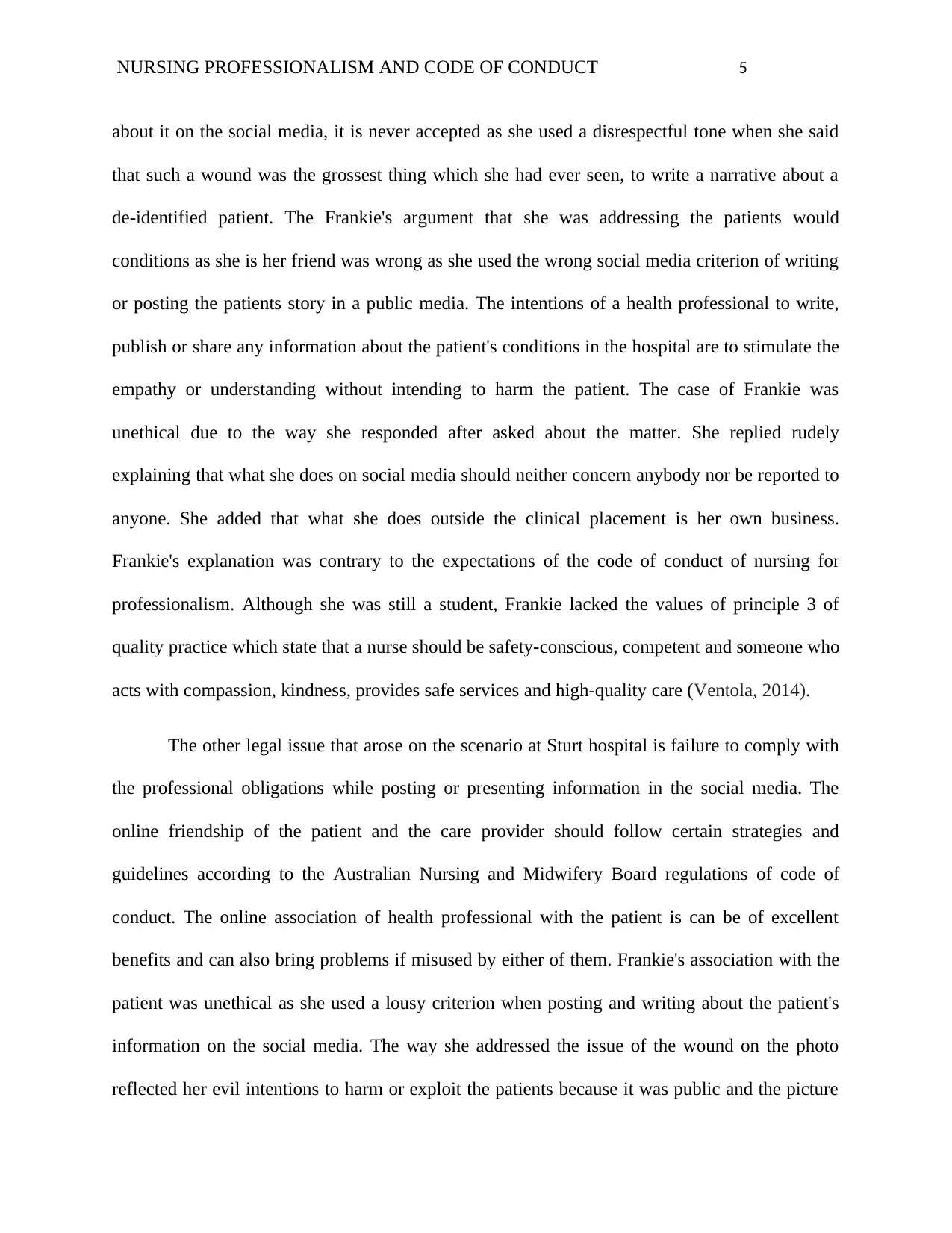
NURSING PROFESSIONALISM AND CODE OF CONDUCT 5
about it on the social media, it is never accepted as she used a disrespectful tone when she said
that such a wound was the grossest thing which she had ever seen, to write a narrative about a
de-identified patient. The Frankie's argument that she was addressing the patients would
conditions as she is her friend was wrong as she used the wrong social media criterion of writing
or posting the patients story in a public media. The intentions of a health professional to write,
publish or share any information about the patient's conditions in the hospital are to stimulate the
empathy or understanding without intending to harm the patient. The case of Frankie was
unethical due to the way she responded after asked about the matter. She replied rudely
explaining that what she does on social media should neither concern anybody nor be reported to
anyone. She added that what she does outside the clinical placement is her own business.
Frankie's explanation was contrary to the expectations of the code of conduct of nursing for
professionalism. Although she was still a student, Frankie lacked the values of principle 3 of
quality practice which state that a nurse should be safety-conscious, competent and someone who
acts with compassion, kindness, provides safe services and high-quality care (Ventola, 2014).
The other legal issue that arose on the scenario at Sturt hospital is failure to comply with
the professional obligations while posting or presenting information in the social media. The
online friendship of the patient and the care provider should follow certain strategies and
guidelines according to the Australian Nursing and Midwifery Board regulations of code of
conduct. The online association of health professional with the patient is can be of excellent
benefits and can also bring problems if misused by either of them. Frankie's association with the
patient was unethical as she used a lousy criterion when posting and writing about the patient's
information on the social media. The way she addressed the issue of the wound on the photo
reflected her evil intentions to harm or exploit the patients because it was public and the picture
about it on the social media, it is never accepted as she used a disrespectful tone when she said
that such a wound was the grossest thing which she had ever seen, to write a narrative about a
de-identified patient. The Frankie's argument that she was addressing the patients would
conditions as she is her friend was wrong as she used the wrong social media criterion of writing
or posting the patients story in a public media. The intentions of a health professional to write,
publish or share any information about the patient's conditions in the hospital are to stimulate the
empathy or understanding without intending to harm the patient. The case of Frankie was
unethical due to the way she responded after asked about the matter. She replied rudely
explaining that what she does on social media should neither concern anybody nor be reported to
anyone. She added that what she does outside the clinical placement is her own business.
Frankie's explanation was contrary to the expectations of the code of conduct of nursing for
professionalism. Although she was still a student, Frankie lacked the values of principle 3 of
quality practice which state that a nurse should be safety-conscious, competent and someone who
acts with compassion, kindness, provides safe services and high-quality care (Ventola, 2014).
The other legal issue that arose on the scenario at Sturt hospital is failure to comply with
the professional obligations while posting or presenting information in the social media. The
online friendship of the patient and the care provider should follow certain strategies and
guidelines according to the Australian Nursing and Midwifery Board regulations of code of
conduct. The online association of health professional with the patient is can be of excellent
benefits and can also bring problems if misused by either of them. Frankie's association with the
patient was unethical as she used a lousy criterion when posting and writing about the patient's
information on the social media. The way she addressed the issue of the wound on the photo
reflected her evil intentions to harm or exploit the patients because it was public and the picture
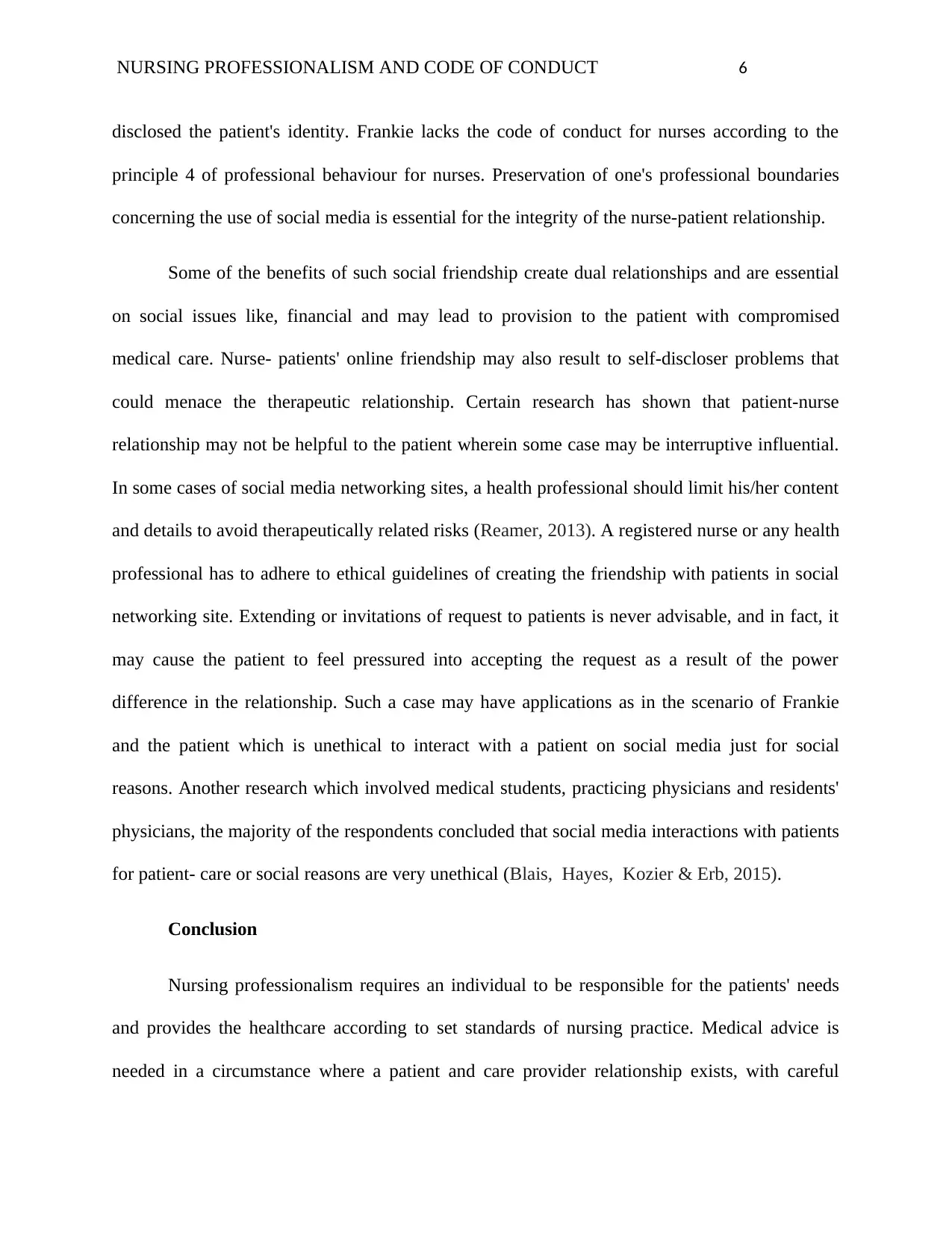
NURSING PROFESSIONALISM AND CODE OF CONDUCT 6
disclosed the patient's identity. Frankie lacks the code of conduct for nurses according to the
principle 4 of professional behaviour for nurses. Preservation of one's professional boundaries
concerning the use of social media is essential for the integrity of the nurse-patient relationship.
Some of the benefits of such social friendship create dual relationships and are essential
on social issues like, financial and may lead to provision to the patient with compromised
medical care. Nurse- patients' online friendship may also result to self-discloser problems that
could menace the therapeutic relationship. Certain research has shown that patient-nurse
relationship may not be helpful to the patient wherein some case may be interruptive influential.
In some cases of social media networking sites, a health professional should limit his/her content
and details to avoid therapeutically related risks (Reamer, 2013). A registered nurse or any health
professional has to adhere to ethical guidelines of creating the friendship with patients in social
networking site. Extending or invitations of request to patients is never advisable, and in fact, it
may cause the patient to feel pressured into accepting the request as a result of the power
difference in the relationship. Such a case may have applications as in the scenario of Frankie
and the patient which is unethical to interact with a patient on social media just for social
reasons. Another research which involved medical students, practicing physicians and residents'
physicians, the majority of the respondents concluded that social media interactions with patients
for patient- care or social reasons are very unethical (Blais, Hayes, Kozier & Erb, 2015).
Conclusion
Nursing professionalism requires an individual to be responsible for the patients' needs
and provides the healthcare according to set standards of nursing practice. Medical advice is
needed in a circumstance where a patient and care provider relationship exists, with careful
disclosed the patient's identity. Frankie lacks the code of conduct for nurses according to the
principle 4 of professional behaviour for nurses. Preservation of one's professional boundaries
concerning the use of social media is essential for the integrity of the nurse-patient relationship.
Some of the benefits of such social friendship create dual relationships and are essential
on social issues like, financial and may lead to provision to the patient with compromised
medical care. Nurse- patients' online friendship may also result to self-discloser problems that
could menace the therapeutic relationship. Certain research has shown that patient-nurse
relationship may not be helpful to the patient wherein some case may be interruptive influential.
In some cases of social media networking sites, a health professional should limit his/her content
and details to avoid therapeutically related risks (Reamer, 2013). A registered nurse or any health
professional has to adhere to ethical guidelines of creating the friendship with patients in social
networking site. Extending or invitations of request to patients is never advisable, and in fact, it
may cause the patient to feel pressured into accepting the request as a result of the power
difference in the relationship. Such a case may have applications as in the scenario of Frankie
and the patient which is unethical to interact with a patient on social media just for social
reasons. Another research which involved medical students, practicing physicians and residents'
physicians, the majority of the respondents concluded that social media interactions with patients
for patient- care or social reasons are very unethical (Blais, Hayes, Kozier & Erb, 2015).
Conclusion
Nursing professionalism requires an individual to be responsible for the patients' needs
and provides the healthcare according to set standards of nursing practice. Medical advice is
needed in a circumstance where a patient and care provider relationship exists, with careful
⊘ This is a preview!⊘
Do you want full access?
Subscribe today to unlock all pages.

Trusted by 1+ million students worldwide
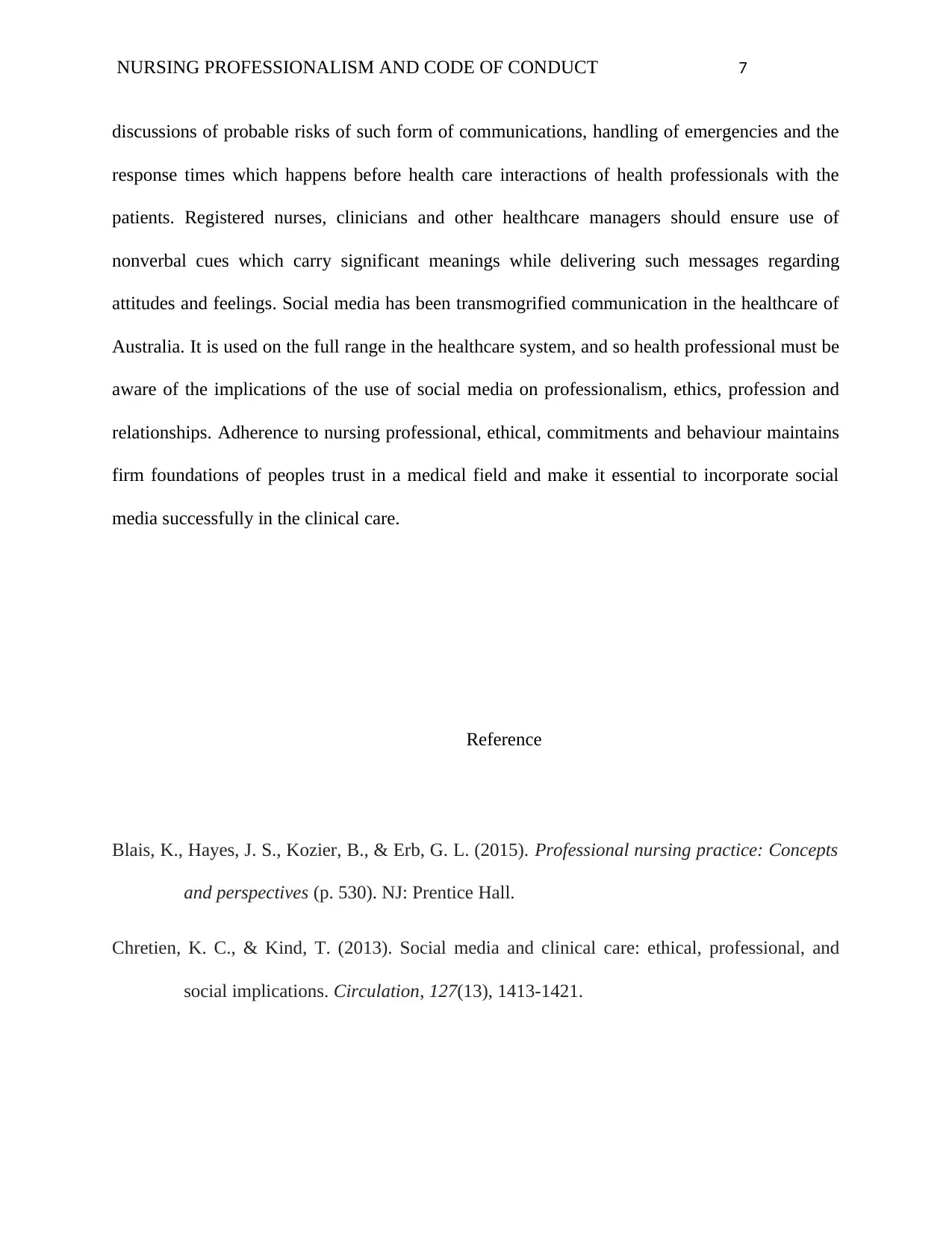
NURSING PROFESSIONALISM AND CODE OF CONDUCT 7
discussions of probable risks of such form of communications, handling of emergencies and the
response times which happens before health care interactions of health professionals with the
patients. Registered nurses, clinicians and other healthcare managers should ensure use of
nonverbal cues which carry significant meanings while delivering such messages regarding
attitudes and feelings. Social media has been transmogrified communication in the healthcare of
Australia. It is used on the full range in the healthcare system, and so health professional must be
aware of the implications of the use of social media on professionalism, ethics, profession and
relationships. Adherence to nursing professional, ethical, commitments and behaviour maintains
firm foundations of peoples trust in a medical field and make it essential to incorporate social
media successfully in the clinical care.
Reference
Blais, K., Hayes, J. S., Kozier, B., & Erb, G. L. (2015). Professional nursing practice: Concepts
and perspectives (p. 530). NJ: Prentice Hall.
Chretien, K. C., & Kind, T. (2013). Social media and clinical care: ethical, professional, and
social implications. Circulation, 127(13), 1413-1421.
discussions of probable risks of such form of communications, handling of emergencies and the
response times which happens before health care interactions of health professionals with the
patients. Registered nurses, clinicians and other healthcare managers should ensure use of
nonverbal cues which carry significant meanings while delivering such messages regarding
attitudes and feelings. Social media has been transmogrified communication in the healthcare of
Australia. It is used on the full range in the healthcare system, and so health professional must be
aware of the implications of the use of social media on professionalism, ethics, profession and
relationships. Adherence to nursing professional, ethical, commitments and behaviour maintains
firm foundations of peoples trust in a medical field and make it essential to incorporate social
media successfully in the clinical care.
Reference
Blais, K., Hayes, J. S., Kozier, B., & Erb, G. L. (2015). Professional nursing practice: Concepts
and perspectives (p. 530). NJ: Prentice Hall.
Chretien, K. C., & Kind, T. (2013). Social media and clinical care: ethical, professional, and
social implications. Circulation, 127(13), 1413-1421.
Paraphrase This Document
Need a fresh take? Get an instant paraphrase of this document with our AI Paraphraser
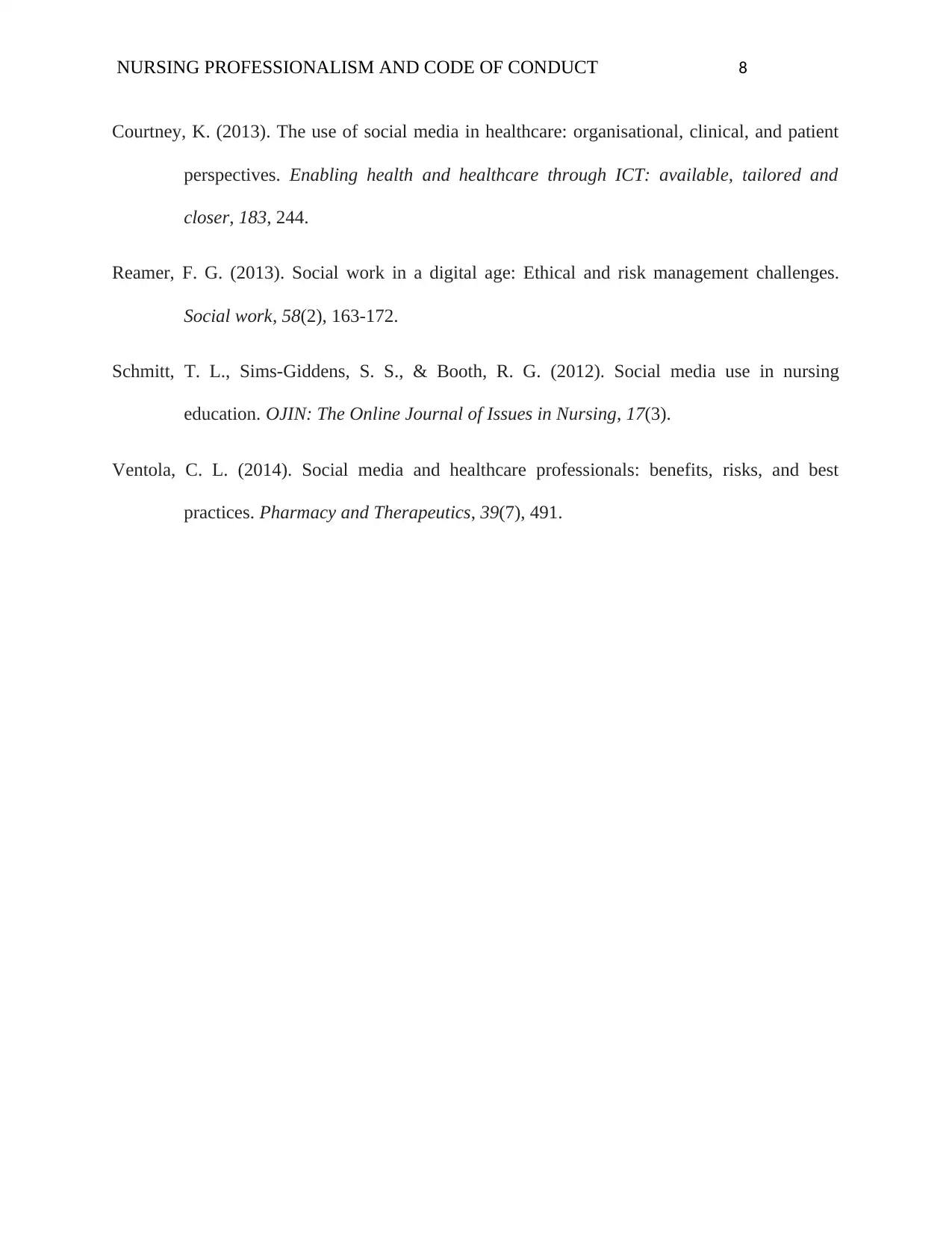
NURSING PROFESSIONALISM AND CODE OF CONDUCT 8
Courtney, K. (2013). The use of social media in healthcare: organisational, clinical, and patient
perspectives. Enabling health and healthcare through ICT: available, tailored and
closer, 183, 244.
Reamer, F. G. (2013). Social work in a digital age: Ethical and risk management challenges.
Social work, 58(2), 163-172.
Schmitt, T. L., Sims-Giddens, S. S., & Booth, R. G. (2012). Social media use in nursing
education. OJIN: The Online Journal of Issues in Nursing, 17(3).
Ventola, C. L. (2014). Social media and healthcare professionals: benefits, risks, and best
practices. Pharmacy and Therapeutics, 39(7), 491.
Courtney, K. (2013). The use of social media in healthcare: organisational, clinical, and patient
perspectives. Enabling health and healthcare through ICT: available, tailored and
closer, 183, 244.
Reamer, F. G. (2013). Social work in a digital age: Ethical and risk management challenges.
Social work, 58(2), 163-172.
Schmitt, T. L., Sims-Giddens, S. S., & Booth, R. G. (2012). Social media use in nursing
education. OJIN: The Online Journal of Issues in Nursing, 17(3).
Ventola, C. L. (2014). Social media and healthcare professionals: benefits, risks, and best
practices. Pharmacy and Therapeutics, 39(7), 491.
1 out of 8
Related Documents
Your All-in-One AI-Powered Toolkit for Academic Success.
+13062052269
info@desklib.com
Available 24*7 on WhatsApp / Email
![[object Object]](/_next/static/media/star-bottom.7253800d.svg)
Unlock your academic potential
Copyright © 2020–2025 A2Z Services. All Rights Reserved. Developed and managed by ZUCOL.





